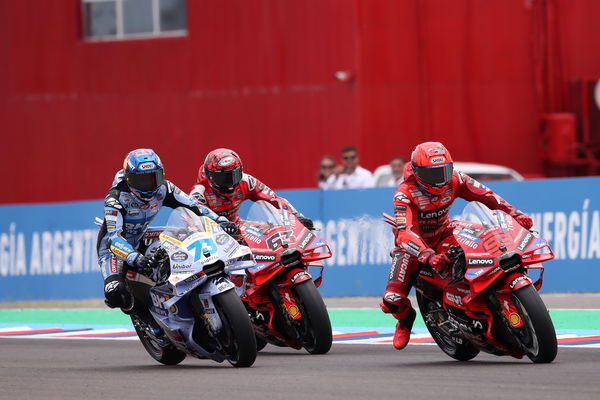Evel Knievel’s Greatest Stunts
The late stunt bike legend is back in the news – but which were his biggest and best jumps?
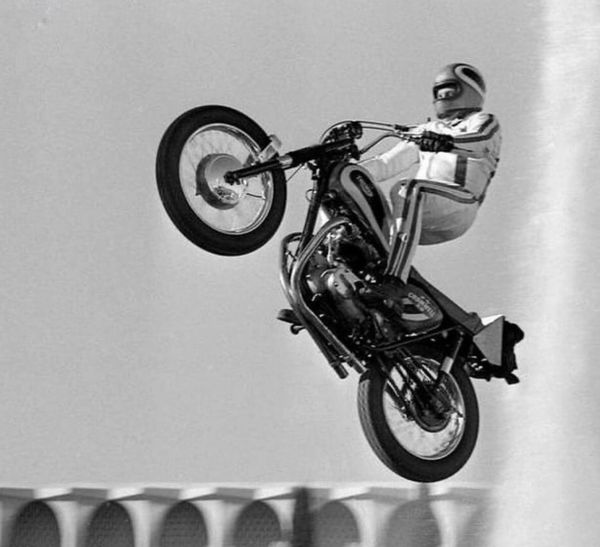
With the recent launch of two new commemorative bikes marking the partnership between Triumph and legendary motorcycle stunt rider Evel Knievel, it got us thinking.
Firstly, we always assumed Knievel was more closely associated with Harley-Davidson – so what’s this Triumph link all about? And second, with it now nearly 50 years since Knievel’s most famous televised attempted jump at Wembley Stadium over 13 buses, maybe now’s a good time to remind ourselves a little of what Knievel was all about, his greatest jumps – and which bikes he did them on.
As reported here the new commemorative Triumphs are the Rocket 3 R and GT Evel Knievel Limited Editions (below) built to honour the relationship between Triumph and Knievel, from his first televised performance riding a Bonneville T120 in 1967, to his breakthrough leap over the fountains at Caesars Palace at the end of that year.
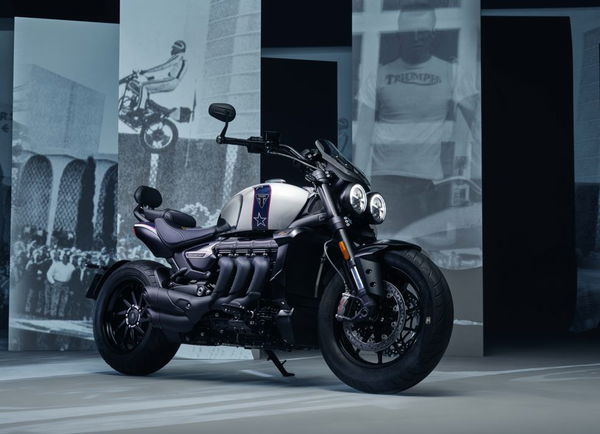
He continued to ride Triumphs up to September 1969 before switching briefly to Honda’s CL350 Scrambler, then Laverda 750 twin-powered American Eagles, before switching to Harley’s new flat-track racer, the XR750, at the end of 1970. He stuck with Harleys up to his last jump in 1977 although did associate with Triumph for his Skycycle jump in 1974 and also returned to Bonnevilles for some non-jumping appearances in 1979 and ’80.
The Triumph period is a significant one, marking his breakthrough into the big time. As Triumph Motorcycles’ Chief Commercial Officer, Paul Stroud, said: “Evel Knievel performed many stunts on Triumph motorcycles during the 60’s, but his jump at Caesar’s Palace on a T120 TT, was the moment he created a legend that has inspired generations of fans.”
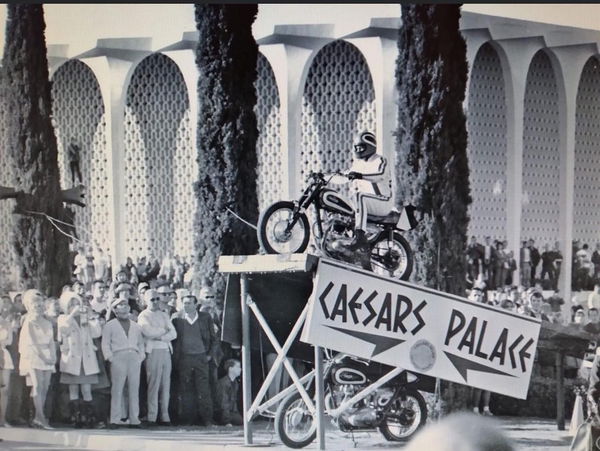
But it’s not the only one – nor the only bike he used. Here, in chronological order, we pick out Knievel’s greatest moments – and motorcycles.
Robert Craig ‘Evel’ Knievel (October 17, 1938 – November 30, 2007) was an iconic American motorcycle stunt performer and showman, performing ramp-to-ramp motorcycle jumps during a career that took him from rural county fairs to sold-out stadiums, made him one of the most famous names of the 1970s and even spin-off movies and toys.
Born in Montana and raised by his grandparents, Knievel was inspired to become a motorcycle daredevil after attending an auto daredevil show, with his iconic ‘Evel’ name reportedly coming about after a police chase in 1956 which ended in a crash saw Knievel placed in a next to a William Knoffel who was known locally as ‘Awful Knoffel’. The guard then referred to Knievel as ‘Evil Knievel’ with the tag sticking but re-spelt as he didn’t want to be considered ‘evil!’

Over his subsequent career, he performed more than 175 jumps, some successful, others less so, and is also recognised by Guinness World Records as having broken or re-broken more bones than anyone in history, with the total listed at 433 (although this is likely exaggerated). But despite failed jumps, crashes and multiple broken bones, Knievel always rose to perform again.
He was also pioneeringly successful in his ability to profit from his image through endorsements and marketing deals. His fame led to innumerable TV appearances and commercial partnerships and from 1972 to 1977 Ideal Toys reportedly sold over $125 million worth of Knievel toys. However, Knievel made his last jump in 1977, and his image was later tarnished by an assault conviction and jail time. He died in 2007 at just 69 due to a combination of diabetes and idiopathic pulmonary fibrosis but his name and legacy are remembered to this day.
1965, Moses Lake, Washington
Knievel’s first display jump is so little known its exact date isn’t even recorded. What is known is it was aboard a Honda 305cc scrambler, about 12 metres long, ramp to ramp with, of all things, some rattlesnakes and two mountain lions in between. Although successful, Knievel’s landing was so heavy he sprained his ankle. It was just a taster of what was to come.
1 June 1966, Kellogg, Idaho
After switching to a Norton 750, Knievel turned his attention to doing ever-longer jumps over, predominantly, vehicles. His first jump over cars came at Kellogg where he cleared 12 over a distance of about 20 metres.
25 March 25 1967, Ascot Park, Gardena, California
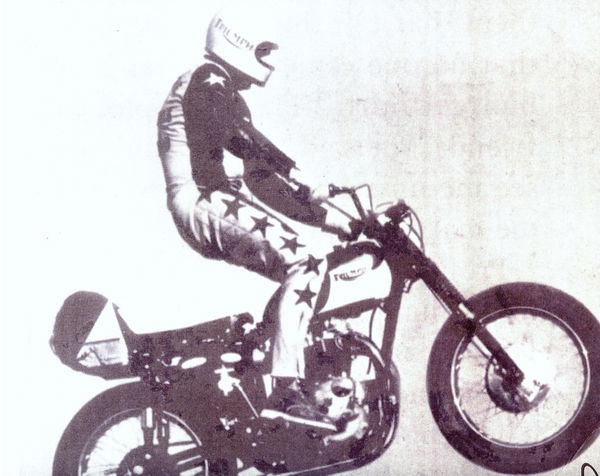
Knievel’s first televised jump was also his first on a Triumph and was when he first received national exposure with his appearance on ABC’s ‘Wide World of Sports’ jumping a 650cc Bonneville T120 over 15 cars at Ascot Park Speedway. This jump predated Evel’s now iconic white jumpsuit and cape. Instead, he wore yellow and black leathers, but would return to Ascot a few months later to jump 16 cars – this time sporting a white jumpsuit for the first time.
31 Dec 1967, Caesar’s Palace, Las Vegas
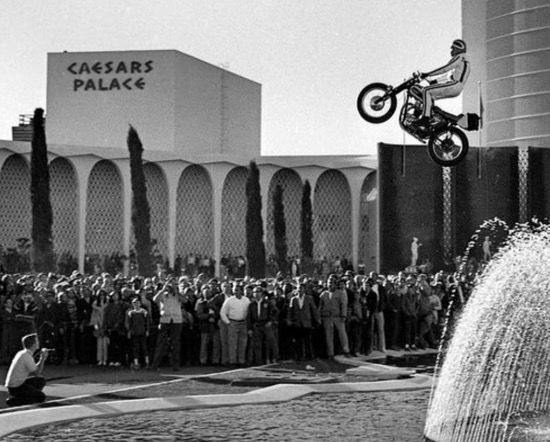
Eight months later, Knievel shot to worldwide fame when, at year’s end, he took on the longest attempt of his entire career – 141 feet over the fountains of the Caesar’s Palace casino in Las Vegas. Ahead of the New Year’s Eve festivities, thousands gathered outside to watch the attempt but, after soaring over the fountains, Knievel lost control on landing and crashed spectacularly suffering a concussion, multiple broken ribs, broken left hip, crushed pelvis, broken jaw and a broken nose.
“I was hurt real bad,” he said. After spending 29 days in a coma, Knievel woke to discover he was internationally famous.
1969-1974 Knievel’s Golden era
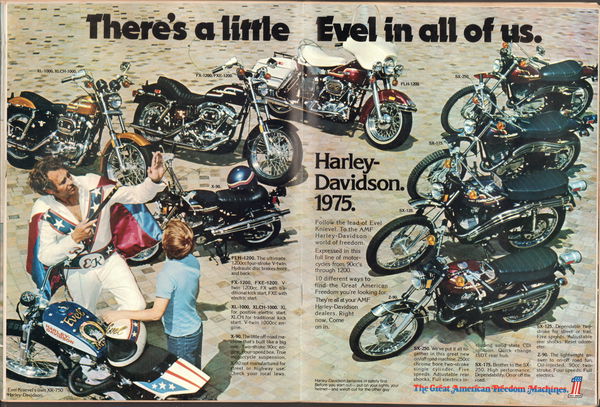
In 1969 Knievel did a deal to ride the Laverda-powered ‘American Eagle’ 750 twin which he used up to the end of 1970, completing many jumps including clearing 18 cars over 120 feet in a jump in Washington in April of that year. In December he switched to the new Harley-Davidson XR750 flat track racer with which he’s most famously associated and on which he undertook well over 50 big jumps around the world, a period which established Knievel as the world’s leading motorcycle stuntman.
8 September 1974, Snake River Canyon, Idaho

Of all the outrageous stunts Evel Knievel performed, the most outlandish was probably his attempt to leap over the quarter-mile-wide Snake River Canyon in Idaho, using a steam-powered rocket dubbed the X-2.
But long before the X-2 was built, Evel had planned to make the jump on a heavily modified Triumph Bonneville T120 he referred to as the ‘Skycycle’. The original idea had been to jump over the Grand Canyon, and a mocked-up Triumph was shown at events to drum up publicity for the jump. The dummy Bonneville was fitted with four-foot delta wings, a seatbelt, a parachute, and two jet booster engines.
Permission for the Grand Canyon stunt was refused by the US National Park Service, so, after flying over it one day, he switched his attention to the narrower, but still imposing, Snake River Canyon instead. Even so, it became apparent that it would take a different kind of vehicle than a conventional motorcycle to make such a huge jump so Knievel adapted his plans and, with US-Navy rocket engineer Bob Truax, developed a super-heated, steam-powered rocket dubbed it the Skycycle X-2.
On 8 September 1974, after months of hyperbole, Knievel pressed the launch button and shot up a ramp, set at a 56-degree angle, hoping to reach a maximum speed of 394mph five seconds into the flight, before both he and his Skycycle X-2 drifted down to safety on the other side of the canyon with the use of parachutes. It was one of the most spectacular, and dangerous, stunts ever attempted… but, ultimately, failed. The rocket’s drogue parachute deployed on take-off, causing Knievel to lose control. He crash-landed against a rocky outcrop a few feet from the river, surviving the crash relatively unhurt.
26 May 1975, Wembley Stadium, UK
For us Brits, undoubtedly Knievel’s most famous jump. Live on TV, the great man, after much bally-hoo and build-up, attempted to jump 13 single-decker buses over a distance of 120 feet. He almost made it, too, clipping the last bus which flipped him off and resulted in TV footage that was probably far more exciting than if he’d actually cleared the jump.
Hobbling off to a hero’s cheer the great man was later found to have sustained a fractured pelvis, broken hand and concussion and his true legendary status was assured. Five months later, Knievel successfully cleared 14 Greyhound buses in a jump at Kings Island Amusement Park, Ohio.
31 Jan 1977, Chicago, US
What proved to be Knievel’s last display jump was also unsuccessful. A planned jump over a 90-foot tank containing 13 sharks, Knievel would again be using his faithful XR750 but crashed heavily during a practice jump which resulted in a fractured collarbone and right arm plus heavy bruising – injuries that, on top of previous ones, spelt the end of his jumping career, although he did later make a series of appearances, wheelieing a Triumph Bonneville. His final public performance was in Puerto Rico in March of 1980, meaning Evel Knievel saw out his career on a Triumph - the same manufacturer with whom he had originally made his name.

